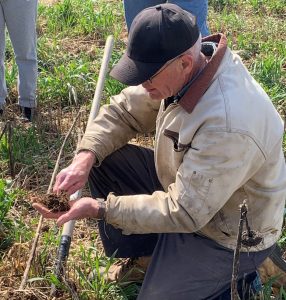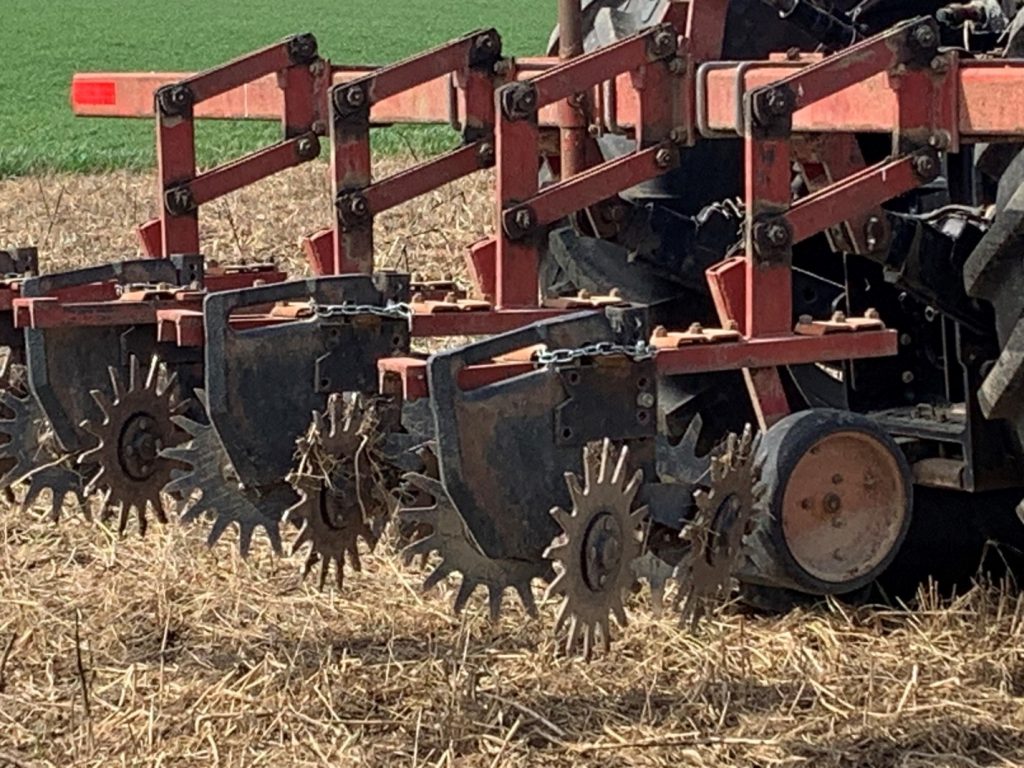By: Nancy Van Sas, Golden Horseshoe Regional Communication Coordinator
On the morning of April 20, 2023, producers were invited to attend Nick Stokman’s Middlesex County farm located north of Strathroy as part of a Knowledge Sharing Event (KSE) supported under the Ontario On-Farm Climate Action Fund (OFCAF) initiative. Nick is entering into his fourth season using biostrip technology on his farms with great success.

Biostrip tillage is the practice of using roots instead of iron to till the soils. Different varieties of cover crops are planted in rows or ‘strips’ with winter kill rows becoming the location of the seed bed for the following grain year and the alternate ‘strips’ planted with overwintering species to become the wheel tracks. The equipment investment includes a combine and a good chaff spreader, a seeder with the capability to plant two different seed mixes, an optional shield sprayer to eliminate volunteer wheat while allowing for the rest of the cover crop to continue growing, row cleaners discretionarily used to prepare the strips for spring planting if the seed bed warrants it, and plenty of patience.
This plant green effect enables reduced tillage in the rotation with the goal to decrease or eliminate erosion from occurring. The cover crops selected can range from a single variety to a complex mixture depending on the desired result and comfort level of the producer. The ability to break up the soil such as with radish, the ability for nitrogen fixing such as with clover, and the ability for weed suppression such as with cereal rye can certainly be part of the mix.
As part of the ONFARM Research Project of OSCIA as Soil Health BMP Trial Site #4, Nick has experimented with biostrip tillage on a variety of soil types, ranging from a clay-loam with patches of denser clay in the hollows on the subject field to the lighter sandy soils when farming Strathmere Lodge Demonstration Farm. His farms have been under no-till production for over 30 years, receiving laying hen manure. The cover crop mix he has selected for the 2022/2023 growing season included 11.5 lbs/acre Austrian winter peas, 11.5 lbs/acre forage peas, 17.25 lbs/acre faba beans and 5.75 lbs/acre part sunflower for the seed bed. For the wheel track mix, Nick included 12.4 lbs/acre oats, and 6.2 lbs/acre each of cereal rye, winter triticale, and winter barley, with some left over radish and double cut clover seed added in as an afterthought.
Farming on a dime, Nick is proving that the technology behind the science does not need to be expensive. Aside from RTK autosteer, he has taken the Frugal Farmer Approach by cobbling together old parts laying around the farm to create his biostrip till row cleaner unit. With Yetter finger wheel row cleaners that have been sitting in the barn since converting to no till in the 1990s, Nick attached them to an old cultivator he found in the back corner of a neighbour’s shed and with the ‘magic of welding 101’, created his row cleaner unit.

According to Ian McDonald, ‘Most people used to tillage would not be happy with this, but you do not need to be 100% cleared. You only need to be about 75% to 85% cleared and then no-till planters work great. It is not really a no-till planter any more in this context, but a regular planter as so much has come off no-till planters in the last number of years.’
It can be a struggle to balance soil health and profitability. Often, it can take many years to see the agronomic benefit of improving soil health. With Nick keeping it simple, he has already seen the benefits offsetting the invested cost on his farms using the biostrip technology. One such improvement includes his levels balancing out better under this system. On a farm high with phosphorus and potassium, he is finally seeing a decline in potassium with the removal of his straw. Ian McDonald noted, ‘Some people would not like the straw coming off if they are really into the soil health, but if this is all the tillage that you are doing in the system and you are leaving those root systems undisturbed, there is no problem taking that straw off’. Indeed, ‘it’s really not tillage, the row cleaners are not moving soil, they are only pushing aside the dead cover crop residue situated in the corn row area of the field.’
There are many benefits for soil health using this approach and Nick has proven it does not have to break the bank for it to work. Here are a few reasons why you may want to think about adopting it onto your farm:
- Assist with reducing or possibly eliminating soil erosion
- Green manure provides food for microorganisms
- Depending on the mix, nitrogen fixation/creation, weed suppression, and breaking up compaction
- Soils heat up faster than with no-till
- Mixtures of roots to aerate the soil by letting the roots do the tillage instead of iron
- With proper management and selection of the living cover crops, retain moisture with the dead cover crop on the surface.
The next question is, will biostrip technology work for you?